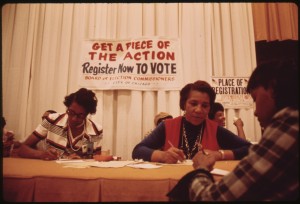
Vote Registration Drive, 1973 – from the US National Archives
My wife loves voting in person – something about going to share the experience of performing one’s civic duty while seeing others do the same – I think it’s inspiring to her. It’s the perfect setting to nourish her inner Leslie Knope. To me, it’s both frustratingly inefficient and an embarrassment in the state of some of our public services compared to the private sector. Of course, they’re not all like that, but the examples that come to mind tend to be sluggish. This round, I opted for a mail ballot.
So the main problem with voting in the polling place is waiting to verify one’s identity in order to get a ballot. If I were to define it in terms of a user goal from my point of view, it would be: “As a software designer, I want to participate in my democracy without having to wait too long so that I can finish up a project for work.” On a mass scale, there’s an argument that the lines and other hassle involved in registration contribute to a low voter turnout.
Last time I voted, there were two lines. I was in the one that stretched out the door of the polling place for people with last names beginning with A-M. On the other side, there was a line that was about one third to half the length of mine that was for people with last names beginning N-Z. This approach of splitting lines by the middle of the alphabet would make sense if last names were evenly distributed between those two halves, but they’re not. A still somewhat crude but more sensible approach would be to look at the national distribution of last names by initial letter and place the split such that close to 50% of the population ends up on either side. Apparently, the rule of thumb is to split A-K and L-Z. A smarter approach would be to arrange the split where registered voters for the particular polling place would end up 50% on each side. More dynamic would be to have a single line and have the next available poll worker call up the next person (like at airport security checkpoints, or like a human load balancer). This would require poll workers to grab from a single pile of ballots, but perhaps it would be worth it since waiting for one’s ballot is not the bottleneck.
Then there’s electronic voting. Lots of countries, particularly many in Europe are doing it. I don’t think there’s any dispute that it would have a huge impact on voter turnout. There’s a quite prolific independent blog dedicated to the effort in the US, but of course there are security concerns as noted by this CNN article.
In my case, I found out that my mail ballot requires postage of $1.30-something, and unfortunately, my stamp collection doesn’t include a stamp of anything near that denomination (just kidding – I don’t really have a stamp collection). At least the Postal Service offers online printable postage. But that’s an experience that could also be (greatly) improved.